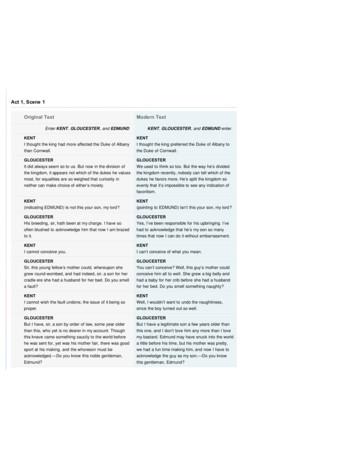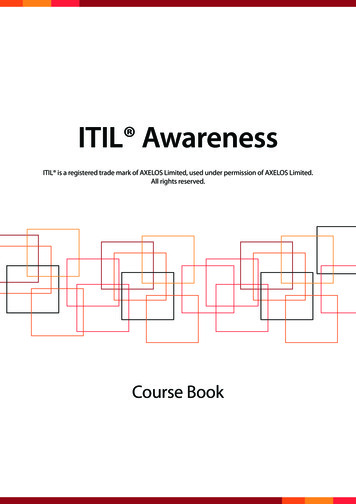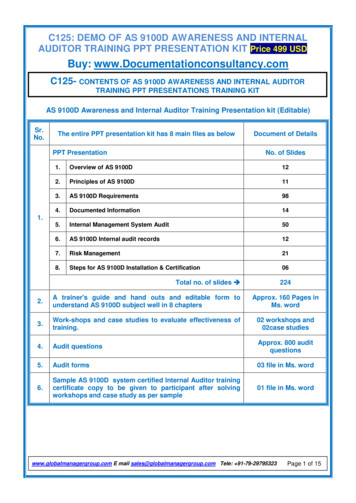
Transcription
Financial Awareness NotesFree GK e-bookFinancial Awareness is an important part of the GA/GS/GK section in various Bank and GovernmentExams like NABARD, IBPS RRB, SBI PO and Clerk, IBPS PO and Clerk, RBI Grade B and Assistant, SSCExams, UPSC and more. Check out some important topics in this eBook to prepare for financialawareness section. In this eBook you’ll find: FinanceImportant Financial TermsIndian Financial SystemForeign Exchange ReservesInternational Financial InstitutionsIndian EconomyStructure and Functions of RBISubsidiaries of RBIGDP and GNPNDP and NNPMIBOR and MIBIDBalance of Trade and Balance ofPaymentFinancial Inclusion (FI) GST e-way BillIndian CurrencyNegotiable InstrumentsCheques and its TypesCrossing of ChequesElectoral BondsBancassuranceBanking Ombudsman Scheme(2006)Confusing Banking TermsImportant Banking TerminologiesBasic Economic terminologiesTop Banking Committees and theirFocus AreaIn competitive exams, as little as 1 mark can make a lot of difference. For your assistance, webring to you a Financial Awareness Free eBook. The following pages of the eBook lists downimportant topics to be covered in this section.To connect directly with our faculty for your queries related to bank and government exams,please download the Telegram App and interact directly with our faculty members. Jointhe Oliveboard Telegram group at obbanking or click on the image provided below:
Financial Awareness NotesFree GK e-bookFinanceFinance plays a crucial role in the operation of any business activity. It is the pivot on which thewhole business process functions, hence, it is also called as life-blood of business organisation.No matter, how big or small business functions are, they need finance to run it effectively. Itprovides security, stability and flexibility to both profit and non-profit organizations in order todevelop goods and services to meet the demands.Definition of FinanceM.Y. Khan and P.K. Jain opines that,“Finance may be defined as the art and science of managing money.”To quote John J. Hapton,“Finance can be defined as the management of the flow of money through an organization,whether it be a corporation, school, bank, or government agency. Finance concerns itself withthe actual flow of money, as well as any claims against money”.Proper planning and controlling of finance lead to the efficient utilization of resources.Managing the finance properly also alter the size and variability of the profitability. Theprofitability could be augmented if the rate of flow of funds could be accelerated while a slowrate may lead to low profits or losses. Hence, Financial Management performs a crucial role inthe survival and success of any business undertaking.Financial ManagementFinancial Management is mainly concerned with the effective management of funds in thebusiness. To put it simply, Financial Management, as practiced by business firms, can be calledas Corporation Finance or Business Finance. It is that managerial activity which is concernedwith the planning and controlling of the firm’s financial resources.According to Weston and Brigham,Financial management “is an area of financial decision-making, harmonizing individual motivesand enterprise goals”.In the words of S.C. Kuchal,“Financial Management deals with the procurement of funds and their effective utilization inthe business”.Objectives of Financial ManagementThe objectives of Financial Management are the maximization of profits, wealth and well-beingof shareholders, minimization of capital cost, etc. Maximization of Profit: The ultimate aim of any economic activity is earning profit. Ithappens when marginal cost is equal to marginal revenue. It is also called as cashing pershare maximization. Wealth maximization means maximization of shareholders’ wealth or wealth of thepersons involved in the business concern. It involves the latest innovation andimprovement in the field of business concern. It is also known as value maximization ornet present maximization. It ensures the economic interest of the society. Survival of company is an important consideration when the financial managers makefinancial decisions. Their incorrect decision(s) may lead the company to be bankrupt. Maintaining proper cash flow is a short-run objective of financial management. It isnecessary for operations to pay the day-to-day expenses e.g. raw material, electricity bills,wages, rent etc. A good cash flow also ensures the survival of company.
Financial Awareness Notes Free GK e-bookMinimization on capital cost in financial management can help operations gain moreprofit.Financial ManagersFinancial manager is a person who is responsible for carrying out the finance functions.Financing is an integral part of managerial functions and the responsibilities assigned forfinancial managers affect the organization’s performance. Thus, the financial manageroccupies a key position in a modern enterprise. He/she, generally, assumes the role in topmanagement team, and, is involved in solving complex fund management problems. Theymanage various tasks, such as, financial forecasting, budgeting, management of cash, creditadministration, financial analysis, etc. they are responsible for shaping the fortune of thecompany and plays dynamic role in decision making.Various functions of the financial managers are: Financial Analysis and PlanningFinancial managers are concerned with the transformation of data into a form so as to monitorthe financial condition; determining whether additional financing is required or not;developing plan to ensure cash flow; achieving firm’s goal, etc. Investment DecisionIt is also referred to as capital expenditure or capital budgeting decision. Investment refers tothe “commitment of resources made in the hope of realizing benefits that are expected tooccur over a reasonably long period of time in future.”Investment decision is a major determinant of company’s efficiency and corporate power. Thefinancial manager, with the objective of ‘value maximization’, makes investment decision toform the framework for a company’s future development. Financing DecisionFinancing decision is concerned with the minimization of cost of capital and maximization ofreturn through developing an appropriate capital structure. The firm can finance its assets byraising funds from various sources such as issue of common stock and preferred stock, issuingbonds/debentures, raising loans, etc. This composition is called capital structure. The financialmanager is concerned with determining the best financing mix or capital structure, both forshort-term and long-term financing.Important Financial Terms1) Standard AssetsStandard assets are those which do not disclose any problems and which do not carry morethan normal risk attached to the business.2) Sub-standard AssetsAn asset classified as an NPA ( non-performing asset ) for less than a period of 12 months isknown as a sub-standard asset.3) Doubtful AssetsThe assets that have been classified as NPAs for a period of more than 12 months are referredto as doubtful assets.
Financial Awareness NotesFree GK e-book4) Loss AssetsAn asset which is considered uncollectible and loss has been identified by the bank or internalor external auditors or the RBI inspection and the loss has not been written off is regarded asloss asset.5) Core Banking Solutions (CBS)Core banking is a banking service provided by a group of networked bank branches wherecustomers may access their bank account and perform basic transactions from any of themember branch offices.Core banking is often associated with retail banking and many banks treat the retail customersas their core banking customers. Businesses are usually managed via the corporate bankingdivision of the institution. Core banking covers basic depositing and lending of money.6) Prime Lending RateA prime rate or prime lending rate is an interest rate used by banks, usually the interest rate atwhich banks lend to favored customers — i.e., those with good credit. Some variable interestrates may be expressed as a percentage above or below prime rate.7) Special Drawing Rights (SDRs)Special Drawing Rights are supplementary foreign-exchange reserve assets defined andmaintained by the International Monetary Fund (IMF). The SDR is the unit of account for theIMF, and is not a currency per se. It represents a claim to currency held by IMF membercountries for which they may be exchanged. SDRs are allocated to countries by the IMF.8) Negotiated Dealing SystemThe Negotiated Dealing System (NDS) facilitates the members to submit bids or applicationsfor primary issuance of Government Securities when auctions are conducted, electronically.NDS also provides an interface to the Securities Settlement System (SSS) of the Public DebtOffice and RBI, thus facilitating settlement of transactions in government securities conductedin the secondary market.9) Asset Management CompaniesAsset management companies provide investors with more diversification and investingoptions than they would have by themselves.Mutual funds, hedge funds and pension plans are all run by asset management companies.These companies earn income by charging service fees to their clients.10) NDS OM : Negotiated Dealing System Order MatchingIt is an online anonymous bond trading platform of the central bank ( RBI ). This is an orderdriven electronic system, where the participants can trade anonymously by placing their orderson the system or accepting the orders already placed by other participants. NDS-OM isoperated by the Clearing Corporation of India Ltd. (CCIL) on behalf of the RBI.
Financial Awareness NotesFree GK e-bookIndian Financial SystemThe ‘Indian Financial System’ is an important topic in the general awareness section of bankingexams. In this blog post, we bring to you everything you need to know about the financialsystem in India.What is a financial system?While performing economic activities some units (such as shops, companies etc.) will be placedin surplus/deficit/balanced budgetary situations.A financial system or financial sector functions as an intermediary and facilitates the flow offunds from the areas of surplus to the areas of deficit. A Financial System is a composition ofvarious institutions, markets, regulations and laws, practices, money manager, analysts,transactions and claims and liabilities.In other terms,A financial system helps in wealth creation by linking savings with investments. It facilitates theflow of funds from the households (savers) to business firms (investors) and thus aids thedevelopment of both sides.The financial system is mostly concerned about money, credit and finance – these terms arerelated but differ from each other as well. The Indian financial system primarily consists of thefollowing: Financial ServicesFinancial Assets/InstrumentsFinancial MarketsFinancial IntermediariesThe following sections discuss each of these in detail.Financial ServicesThese refer to the activities concerning the design and delivery of financial instruments toindividuals and businesses within the area of banking and related institutions, personalfinancial planning, leasing, investment, assets, insurance etc. These include: Operations & services provided by the banks Currency exchange, foreign exchange banking or the wire transfer Asset management, hedge fund management and the custody services Selling insurance policies, brokerages, insurance underwriting or the reinsuranceFinancial MarketsIt is defined as the market in which financial assets are created or transferred. Financialmarkets can be categorized as follows:1. Money Market– It is defined as the market for short-term money and financial assets thatare near substitutes for money. The term short-term means generally a period upto one yearand near substitutes to money is used to denote any financial asset which can be quicklyconverted into money with minimum transaction cost. It can be sub-categorized as follows: Unorganized Market: money lenders, chit funds etc. Organized Money Market: Instruments include: treasury bills, commercial papers,certificate of deposit etc. Organized Markets work as per the rules and regulations of RBI.RBI controls the Organized Financial Market in India.
Financial Awareness NotesFree GK e-book2. Capital Market – The capital market is designed to finance the long-term investments. Thetransactions taking place in this market will be for periods over a year. It can be classified intothree groups: Corporate Securities Market: Corporate securities are equity and preference shares,debentures and bonds of companies. The corporate security market is a very sensitive andactive market. It can be divided into two groups: primary and secondary. Government Securities Market: In this market government securities are bought and sold.The securities are issued in the form of bonds and credit notes. The buyers of suchsecurities are Banks, Insurance Companies, Provident funds, RBI and Individuals. Long-Term Loans Market: Banks and Financial institutions that provide long-term loans tofirms for modernization, expansion and diversification of business. It is further categorizedinto: Term Loans Market, Mortgages Market and Financial Guarantees Market3. Forex Market – The Forex market deals with the multi-currency requirements, which are metby the exchange of currencies. Depending on the exchange rate that is applicable, the transferof funds takes place in this market. This is one of the most developed and integrated marketacross the globe.4. Credit Market– Credit market is a place where banks, FIs and NBFCs purvey short, mediumand long-term loans to corporate and individuals.Financial Assets / InstrumentsFinancial Assets or Financial Instruments represents a claim to the payment of a sum of moneysometime in the future and /or periodic payment in the form of interest or dividend.A financial transaction involves creation or transfer of a financial asset (as against a realtransaction that involves exchange of money for real goods or services).Some important financial assets / instruments are briefly discussed below :1. Call /Notice-Money Market It’s money borrowed or lent on demand for a very short period. Thus money borrowed on a day and repaid on the next working day is called call money. When money is borrowed or lent for more than a day and up to 14 days it is called noticemoney. No collateral is required to cover these transactions.2. Inter-Bank Term MoneyDeposits with maturity period beyond 14 days is referred as the term money. The entryrestrictions are the same as that of Call/Notice Money. However, lending beyond 14 days isnot allowed.3. Treasury BillsThese are short term (up to one year) borrowing instruments of the union government. It is anIOU by the Government (i.e. a promise by the Government to pay a sum of money after expiryof the stated period in less than one year). They are issued at a discount to the face value, andon maturity the face value is paid to the holder. The rate of discount and the correspondingissue price are determined at each auction.
Financial Awareness NotesFree GK e-book4. Certificate of DepositsIt is a negotiable money market instrument and is issued in a de-materialized form or as aPromissory Note, for funds deposited at a bank or other eligible financial institution for aspecified time period.These can be issued by:(i) Scheduled commercial banks excluding Regional Rural Banks (RRBs) and Local Area Banks(LABs)(ii) Select pan India financial institutions that have been permitted by RBI to raise short-termresources within the fixed limit.(iii) Banks have the freedom to issue CoDs depending on their requirements.5. Commercial PaperCP is a note in evidence of the debt obligation of the issuer. It is thus an unsecured promissorynote privately placed with investors at a discount rate to face value determined by marketforces. A company shall be eligible to issue CP provided(i) the tangible net worth of the company is not less than Rs. 4 crores(ii) the working capital (fund-based) limit of the company from the banking system is not lessthan Rs.4 crore and(iii) the borrowal account of the company is classified as a Standard Asset by the financingbank/s.The minimum maturity period of a commercial paper is 7 days.Capital Market InstrumentsIt consists of the following long term period (i.e. more than one year period) financialinstruments: Equity shares, preference shares, convertible preference shares, non-convertiblepreference shares etc Zero coupon bonds, deep discount bonds etc.Financial IntermediationThe role of the financial intermediary is to distribute funds from people who have extra inflowof money to those who don’t have enough money to fulfill the needs.The best example of an intermediary is a bank which transforms the bank deposits to bankloans.Some of the important intermediaries operating in the financial markets include: investmentbankers, underwriters, stock exchanges, registrars, depositories, custodians, portfoliomanagers, mutual funds, financial advertisers financial consultants, primary dealers, satellitedealers, self regulatory organizations, etc.
Financial Awareness NotesFree GK e-bookIntermediaryMarketRoleStock ExchangeCapital MarketSecondary Market to securitiesInvestment BankersCorporate advisory services,Capital Market, Credit Market Issue of securitiesUnderwritersSubscribe to unsubscribedCapital Market, Money Market portion of al MarketIssue securities to the investorson behalf of the company andhandle share transfer activityMoney MarketMarket making in governmentsecuritiesForex MarketEnsure exchange ink currenciesDepositories,DealersForex DealersSatelliteForeign Exchange ReservesForeign Exchange Reserves are the assets held on reserve by the central bank of a country (RBI in India) in foreign currency. They are also called foreign currency reserves or foreignreserves. It is a common practice in nations around the world to hold a significant amount ofreserves in their foreign exchange. Most of these reserves are held in the U.S. dollar since it isthe most traded currency in the world.What is the purpose of Foreign Exchange Reserves ?These assets serve many purposes but most importantly these are held to ensure that a centralgovernment has backup funds if the national currency rapidly devalues or becomes altogetherinsolvent. Foreign currency helps to maintain liquidity in case of economic crisis. Foreignreserves are always required for a nation to meet its external obligations. Theseinclude international payment obligations, including sovereign and commercial debts. Theyalso include financing of imports and the ability to absorb any unexpected capital movements.What are the components of India’s Foreign Exchange Reserves ?The components of India’s Foreign Exchange Reserves include the following : Foreign currency assets (FCA) Gold Reserves Special Drawing Rights (SDR) RBI’s Reserve position with International Monetary Fund (IMF)
Financial Awareness NotesFree GK e-bookInternational Financial InstitutionsAn international financial institution (IFI) is a financial institution that has been established (orchartered) by more than one country, and hence are subjects of international law. Its ownersor shareholders are generally national governments, although other internationalinstitutions and other organizations occasionally figure as shareholders.International financial institutions include public banks, such as the World Bank, InternationalMonetary Fund, and regional development banks. They provide loans, grants, and technicalassistance to governments, as well as loans to private businesses investing in developingcountries.NOTE: Development Financial Institutions (DFIs) occupy the space between public aid andprivate investment. They are financial institutions, which provide finance to the private sectorfor investments that promote development. They focus on developing countries and regionswhere access to private sector funding is limited.The following table shows everything you need to know about the most prominentinternational financial institutions.Name of theInstitutionYear HeadquartersPresidentAfricanDevelopmentBank (ADB)1964 Abidjan,Côte d’IvoireAkinwumiAdesinaAsianDevelopmentBank (ADB)1966 Mandaluyong, TakehikoPhilippinesNakaoFunctionsIt is established to contribute to theeconomicdevelopment and social progress ofAfrican countries.The primary function is to provideloans andequity investments for the socioeconomicadvancement, technical assistancefordevelopment projects, and assists inorganizingthe development policies.It works on reducing poverty in Asiaand the Pacificthrough inclusive economic growth,environmentallysustainable growth, and regionalintegration.This is carried out throughinvestments in the formof loans, grants and informationsharing.
Financial Awareness NotesAsianInfrastructureInvestment Bank(AIIB)Free GK e-book2015 Beijing, China Jin LiquinIts function is to support thebuilding of infrastructurein the Asia-Pacific region. The bankhas 50 memberstates (all “Founding Members”)and was proposedas an initiative by the governmentof China.European Bank for 1991 bartiIt offers project financing for banks,industriesand businesses, for new ventures orexistingcompanies. It works with publiclyowned companiesto support their privatization, asadvocated by theWTO since the 1980 and in theimprovement ofmunicipal services.EuropeanInvestmentBank (EIB)1958 LuxembourgWerner Hoyer It is a “policy-driven bank” whoseshareholders are the memberstates of theEU. The EIB uses its financingoperationsto bring about European integrationandsocial cohesion.InternationalMonetaryFund (IMF)1944 Washington ChristineD.C.LagardeUnited StatesIslamicDevelopmentBank (IDB)1975 JeddahSaudi ArabiaPromote international monetary cooperation,facilitate international trade, fostersustainable economic growth, makeresources available to membersexperiencingbalance of payments difficulties.AhamadThis is a multilateral developmentMohamedfinancingAli Al Madani institution which helps in thedevelopmentof member states. The basic
Financial Awareness NotesFree GK e-bookcondition formembership is that the prospectivemembercountry should be a member of theOrganization of IslamicCooperation.World Bank Group 1944 Washington Jim Yong Kim The World Bank focuses on(WBG)D.C.developingUnited Statescountries in fields such as:human development,agriculture and rural development,environmental protection,infrastructure,large industrial constructionprojects,and governance.Indian EconomyAn economy includes all activities related to consumption, production, trade of goods andservices in an area. It applies to everyone from individuals to entities such as corporations andgovernments. The economy of a country is governed by its culture, laws, history, andgeography, among other factors, and it evolves due to necessities of people or nation. Becauseof this reason, no two economies are the same.The economic activities can be grouped on the basis of certain important criterion. Thesegroups are referred as sectors.Different Sectors of Indian EconomyI. Sectors of Indian Economy : Based on Nature of Activity1. Primary Sector: When the goods are produced by exploiting natural resources, it comesunder the activity of the primary sector. It involves transforming natural resources into primaryproducts. It forms the base for all other products that we eventually make. Most of the naturalproducts we get are from agriculture, dairy, fishing, forestry. Therefore, this sector is also calledas Agriculture and Related Sector.Examples of the Primary Sector: Agriculture Fishing Mining Forestry, etc.Generally, it is the larger sector in the developing countries. In developed countries, activitiesof the primary sector have become more technologically advanced, for example, themechanization of farming instead of hand picking and planting.2. Secondary Sector: The secondary sector encompasses activities in which natural productsare changed into other forms, or finished goods by manufacturing that are consequently used
Financial Awareness NotesFree GK e-bookfor consumption. The product has to be made and therefore some process of manufacturingis essential. The manufacturing could be done in a factory, workshop or at home.For example, using cotton fiber from the plant, to spin yarn and weave cloth, or usingsugarcane to make jaggery and refined sugar. The manufacturing process is usually associatedwith the different kinds of industries that come up, therefore, this is also called as IndustrialSector.Secondary Sector is usually divided into Light Industry and Heavy Industry. Light Industry: it involves products that require less capital and is more consumeroriented.Examples: Manufacturing of clothes, Shoes, furniture, etc. Heavy Industry: it involves products that are either heavy in weight or in their productionprocess. They require huge capital and advanced resources or facilities.Examples: Heavy machinery, Chemical Plant, Production of heavy equipments, like crane, etc.3. Tertiary Sector: The activities in tertiary sector helps in the development of the primary andsecondary sectors. These activities do not produce any good, but they are an aid or a supportfor the production process.For example, Certain business activities involve borrowing money from banks to helpproduction and trade or goods that are produced in the primary or secondary sector wouldneed transportation facility to be sold in wholesale or retail shops.Examples of Tertiary Sector: Transport Storage Communication Banking Insurance Trade Hospitality Tourism Entertainment Management ConsultancySince the activities involved in Tertiary Sector generate services rather than goods, it is alsocalled as Service Sector.II. Sectors of Indian Economy : Based on Condition of Work1. Organized sector:It involves those enterprises or places of work where the people are offered some amount ofjob security. The employees are expected to work only a fixed number of hours. In case theywork more, they are to be paid overtime by the employer. They also get several other benefitsfrom the employers, for instance, medical benefits, provident funds, paid-leaves, etc. Theenterprises are registered by the government and have to follow its rules and regulationsunder the provision of various laws such as the Factories Act, Minimum Wages Act, Paymentof Gratuity Act, etc.Examples: Hospitals, Schools, etc. where employees are offered regular job and theorganisation is governed by various laws and regulations.
Financial Awareness NotesFree GK e-book2. Unorganized Sector:Section 2 (l) of the Unorganized Workers Social Security Act, 2008 defines an unorganizedsector as:“an enterprise owned by individuals or self-employed and engaged in the production or saleof goods or providing service of any kind whatsoever, and where the enterprise employsworkers, the number of such workers is less that ten.”The unorganized sector is characterized by small and fragmented units which are mostlyoutside the control of the government. The rules and regulations are, generally, not followed.The Jobs are often not regular and are low-paid. There is no provision for overtime, paid leave,holidays, leave due to sickness, etc. The employees do not have any job security. They can beasked to leave /quit without any reason. Mostly it depends on the whims of the employer. Foreg. The employer may ask the people to quit the job when there is less work.Examples: Large number of people who are employed on their own doing small jobs such asselling on the street or doing repair work, farmers work on their own and hire labourers as andwhen they require, etc.III. Sectors of Indian Economy : Based on Ownership of Assets1.Private Sector: Here, the ownership of assets and delivery of services is in the hands of privateindividuals or companies. For example, Reliance Industries Limited (RIL), Aditya Birla Group,etc.2.Public Sector: In this sector, the government owns most of the assets and provides all theservices. For example, Railways, Post-Offices, etc.Note: Currently, tertiary/service sector is the backbone of the Indian economy, contributing themost in Indian GDP. It accounts for 53.66% of total India’s GVA of 137.51 lakh crore Indianrupees. Industry sector contributes 29.02%. While, Agriculture and allied sector shares 17.32%and GVA is around of 23.82 lakh crore INR.Sectors of Indian Economy : Sample Questions:Q1. Banking comes under which of the following sectors?1. Primary2. Secondary3. Tertiary4. Both Primary and Secondary5. Both Secondary and TertiaryAnswer: 3Q2. The sectors are classified into private and public sector on the basis of:1. The nature of economic activity2. Employment conditions3. Job security4. Ownership of enterprisesAnswer: 4
Financial Awareness NotesFree GK e-bookStructure and Functions of RBIReserve Bank of India (RBI)The Reserve Bank of India was established on April 1, 1935 in accordance with the provisionsof the Reserve Bank of India Act, 1934.The Central Office of the Reserve Bank was initially established in Calcutta but was permanentlymoved to Mumbai in 1937. The Central Office is where the Governor sits and where policiesare formulated.Though originally privately owned, since nationalization in 1949, the Reserve Bank is fullyowned by the Government of India.Structure of RBICentral BoardThe Reserve Bank’s affairs are governed by a central board of directors. The Central Board ofDirectors is the apex body in the governance structure of the Reserve Bank. There are alsofour Local Boards for the Northern, Southern, Eastern and Western areas of the country whichtake care of local interests. The central government appoints/nominates directors to theCentral Board and mem
Financial Awareness Notes Free GK e-book Finance Finance plays a crucial role in the operation of any business activity. It is the pivot on which the whole business process functions, hence, it is also called as life-blood of business organisation. No matter, how big or small business f











